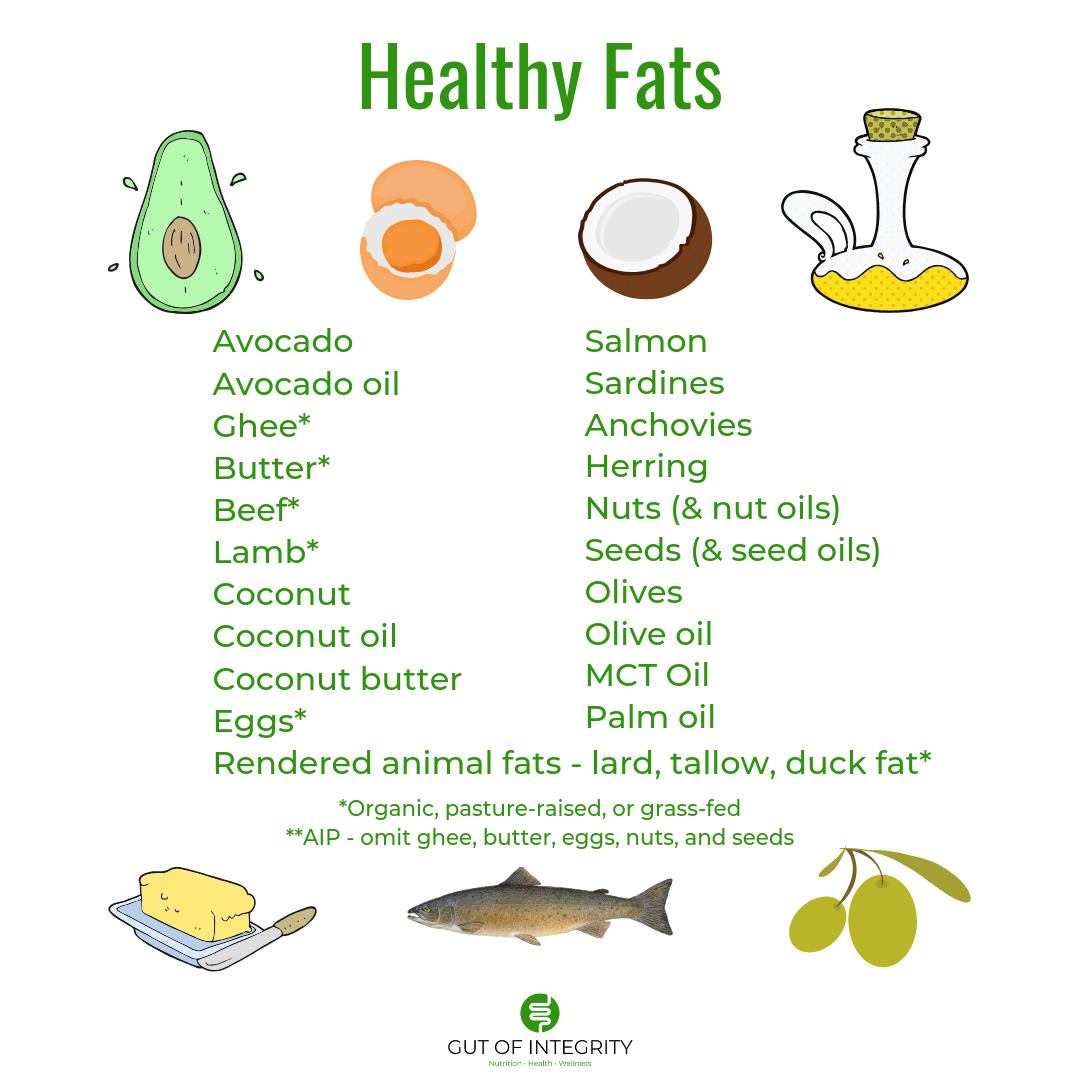Let's Talk About (Dietary) Fat
Raise your hand if you were taught that all dietary fat is bad. It’s OK if you did; the sugar and anti-fat lobbyists made sure that was at the forefront of media conversation from the late 1960s until about 10-15 years ago. The sugar and anti-fat industrial complexes created “low-fat” foods, which meant they removed the fat and added plenty of processed sugar and refined salt to make it taste good, and marketed it in a way that villainized fat for the next 50 years (like saying “eating too much fat causes cardiovascular disease” - it doesn’t - or that “a fat free diet is an important part of any weight loss program” - it isn’t). This smear campaign against fat has, sadly, directly contributed to chronic diseases, including type-2 diabetes, alzheimer’s disease, and metabolic syndrome (there’s no hiding I feel, am I right?).
BOO to that! We need fat in our diet! Fat is used to store energy, make hormones, and transport vitamins. It also insulates the myelin sheath that protects our nerves, makes up the cell membrane that protects our cells, and makes up 60% of our brain. The following is a list of some of the many functions that good fats perform in our bodies:
Building blocks for cell membranes
Provides protection for organs and cells
Regulates body temperature
Calms the nervous system
Precursors for making hormones
Transports for fat-soluble vitamins A, D, E, K (regulate the immune system)
Slows the release of sugar into the bloodstream
Primary source of energy for the heart
Good Fats & Bad Fats - What’s the Difference?
To keep it simple, good fats are naturally occuring and haven’t been damaged by high heat, refining, or overprocessing. Examples of good fats include:
Avocado
Avocado oil
Ghee*
Butter*
Beef*
Lamb*
Coconut
Coconut oil
Coconut butter
Eggs*
Rendered animal fats - lard, tallow, duck fat, schmaltz*
Grass-fed, raw dairy (preferably sheep or goat)
Salmon
Sardines
Anchovies
Herring
Nuts (& nut oils)
Seeds (& seed oils)
Olives
Olive oil
MCT Oil
Palm oil
*Assumes animal products are grass-fed, organic, and/or pastured
Bad fats are damaged and have become oxidized for many reasons. High heat processing removes healthful nutrients, like vitamin E, and creates lipid compounds the body can’t process. If the fat is extracted with solvents, it causes the fat to become rancid and toxic. In addition, trans fats have been hydrogenated, which means that an extra hydrogen molecule was added to the fat during creation, which our body doesn’t recognize and therefore can’t utilize or break it down. The worst fats are:
Partially hydrogenated fat (A.K.A. trans fats): margarine, vegetable shortening, processed foods (read the label!)
Fried foods
Refined vegetable oils
Unrefined vegetable oils in clear glass or plastic bottles (light destroys their beneficial properties)
Any fat in excess; balance is important
What about Cholesterol?
Cholesterol is a hard, waxy substance that is mostly produced in the liver. It’s also found in animal products. Cholesterol is used to form sex and adrenal hormones, vitamin D, and bile (which is needed for the digestion of fats). It’s also an antioxidant and anti-inflammatory. Cholesterol can be problematic but not for the reasons you think - it’s not the level of cholesterol in the blood that’s detrimental but whether or not that cholesterol is oxidized (remember, oxidation = bad fat). Even if you aren’t eating oxidized fats, lifestyle habits can contribute to high cholesterol. Chronic stress, smoking, excess consumption of coffee, alcohol, polyunsaturated vegetable oils, and refined sugar and carbohydrates, along with a diet lacking in anti-inflammatory plant foods and other essential nutrients are all contributing factors to having high cholesterol.
Types of Fats
There are three different types of fat in our diets: saturated, monounsaturated, and polyunsaturated.
Saturated fats have the following properties:
Excellent fuel source
Can be an important part of weight regulation
Lend structure and rigidity to cell walls
Heat-stable at high temperatures, so it can be used for frying and sauteing
Remain solid at room temperature (coconut oil, butter, ghee, rendered animal fats)
Monounsaturated fats are considered health-neutral and are an integral part of the diets of many cultures (Mediterranean, anyone?!). Olives, almonds, macadamia nuts and their oils are all great sources of monounsaturated fats. They remain liquid at room temperature and solid when chilled.
Polyunsaturated fats help maintain proper cell membrane integrity and can also be an important part of weight regulation. These oils are liquid both at room temperature AND when refrigerated. Examples include nuts and seeds, cold-water fish, raw dairy, and fish oil.
Polyunsaturated fats can be broken down even further into omega-3 fatty acids and omega-6 fatty acids, which must come from our diet because we don’t produce them on our own. Omega-3s play an important role in the human body. The three most important types of omega-3s are EPA and DHA (found in animal food and algae), and ALA (found in plants). Omega-3s, especially EPAs and DHAs, provide a variety of health benefits, including reducing inflammation, pain, allergies, dry skin, and swelling. They also play a role in maintaining blood pressure, and they regulate heart, digestive, and kidney function. The fatty acids EPA and DHA are especially critical for the eyes, brain, nervous system, heart and glands. They also promote neurological development in babies and children, so it is important for pregnant and breastfeeding humans to get enough of them.
We need omega-3s in our diet to decrease the inflammation caused by omega-6s. Omega-6s are found in common foods like margarine, vegetable oil shortening, and other foods containing trans-fatty acids and partially-hydrogenated vegetable oils (next time you go to the store, read the labels...you’ll be surprised!).
This results in Americans eating 14 to 25 times more omega-6 fatty acids than omega-3 fatty acids. Bottom line: Americans don’t get enough omega-3s. Adding omega-3s like fish, fish oil and flaxseed oil help reduce the inflammation omega-6s tend to cause. The ideal ratio of omega-3s to omega-6s should be 1:1.
Try subbing flaxseed oil in your salad dressing or eating fish twice a week and you’ll notice a difference! For omnivores, cold-water fish (salmon, sardines, halibut, and mackerel) provide an excellent source of omega-3s (fish oil can be taken in its place in a dosage of 1,000 mg EPA+DHA per day). For vegetarians, great sources include flaxseed oil, walnuts, chia seeds, and algae.
Fat + Mood
It’s important to note that if you’re not eating enough fat, it affects your memory and mood. Fat is imperative to fueling your brain, regulating your hormones, reducing inflammation, and stabilizing your blood sugar, which all play a role in brain health. Fat is rich in vitamins A and E, and omega-3 fatty acids, which can help reduce inflammation when you have depression and boost your brain power. And because fats fill you up, they regulate blood sugar, which alleviates anxiety caused by blood sugar spikes. Blood sugar dysregulation can also spike cortisol and exacerbate symptoms of worry and fear so if you’re looking to counteract symptoms of depression and anxiety, add healthy fats to your diet!
Serving Size
One serving of fat = 1 tablespoon of animal fat/oil or 2 tablespoons of nuts/seeds or 1/4 avocado
Cooking Oils
It’s important to not heat cooking oils past their smoke point, as they will turn rancid if you do! Here’s a trusty guide to help when you cook.
High-temperature Fats (frying, over 375° F)
Ghee
Rendered animal fats (lard, tallow, duck fat, bacon fat, schmaltz)
Palm oil
Medium-temperature Fats (sautéing, baking, up to 375° F)
Avocado oil
Butter
Coconut oil
Olive oil (refined)
Low-temperature Fats (up to 250° F)
Nut oils
Hemp seed oil (do not heat)
Olive oil (extra virgin)
Flax oil (do not heat)
So after all this...eat your fats! You need them!
If there’s anything I missed, please let me know in the comments.
Sources:
Ballantyne, S. (2013). The Paleo Approach. Canada: Victory Belt Publishing, Inc.
Brighten, J. (2019). Beyond the Pill. New York, NY: HarperCollins Publishers.
Bauman, E. (2016). NC101: Eating for Health. In Foundations of Nutrition Textbook (pp. 50). Penngrove, CA: Bauman College.
Gunnars, K. Authority Nutrition. (2015). What are omega-3 Fatty Acids? Explained in Human terms. Retrieved from https://authoritynutrition.com/what-are-omega-3-fatty-acids/
Lipski, E. (2013). Food is Your Best Medicine. In Digestion Connection (pp. 140-141). Emmaus, PA: Rodale, Inc.
Murray, M., Pizzorno, J., and Pizzorno, L. Designing a Healthy Diet. In The Encyclopedia of Healing Foods (p. 24-27). New York, NY: Atria Books.
Murray, M., and Pizzorno, J. A Health Promoting Diet. In The Encyclopedia of Natural Medicine (3rd ed.) (p. 62-63). New York, NY: Atria.


